Analysis of Operational Efficiency: XYZ Company in Egypt
VerifiedAdded on 2023/05/29
|32
|8289
|123
Report
AI Summary
This report provides a comprehensive analysis of the operational management of XYZ Company, a Fast-Moving Consumer Goods (FMCG) company operating in the tea segment in Egypt. The report begins with an executive summary and introduction, outlining the company's background, objectives, and key operational areas. The main body of the report delves into crucial aspects of the company's operations, including forecasting, capacity planning, quality management, production processes, inventory management, and supplier relationships. It identifies key issues such as forecasting inaccuracies, supplier relationship problems, delays in material availability, quality concerns, capacity limitations, and order fulfillment challenges. The report then proposes plausible solutions to address these issues, detailing the application of these solutions and presenting an aggregate plan for the coming period. The analysis incorporates various operational management techniques, methods, and models. The conclusion summarizes the findings and recommendations, offering insights into improving the company's operational efficiency.

Executive Summary
Operation management is study and application of the administration practice
which creates the highest level of efficiency possible in an organization. The
Operation management process is concerned in overseeing the operations of the
company and ensuring their effectiveness & efficiency.
This paper on operation management is intended to critically analyze the operations
and their efficiency of the company XYZ which is engaged in FMCG segment in
Egypt. This report is restricted to analysis of the operational efficiency of the
company in tea segment only.
As it can be observed from the minutes of board meeting that the company is facing
some operations related issues, such as uncertainty in forecasting, capacity
planning, quality management, inventory management & order fulfillment and
Suppliers’ relationship, the report is directed towards critically analyzing these
areas and identify the reasons for the issues and provide plausible solutions. While
doing so all the operational management techniques, methods, and models adopted
in analysis is clearly mentioned.
The entire report is divided into topics such as –
Identification of key operational areas;
Identification of key problems in those operations;
Plausible solutions to address the issues;
Application of the solutions recommended;
Aggregate Plan for coming period; and
Conclusion
Operation management is study and application of the administration practice
which creates the highest level of efficiency possible in an organization. The
Operation management process is concerned in overseeing the operations of the
company and ensuring their effectiveness & efficiency.
This paper on operation management is intended to critically analyze the operations
and their efficiency of the company XYZ which is engaged in FMCG segment in
Egypt. This report is restricted to analysis of the operational efficiency of the
company in tea segment only.
As it can be observed from the minutes of board meeting that the company is facing
some operations related issues, such as uncertainty in forecasting, capacity
planning, quality management, inventory management & order fulfillment and
Suppliers’ relationship, the report is directed towards critically analyzing these
areas and identify the reasons for the issues and provide plausible solutions. While
doing so all the operational management techniques, methods, and models adopted
in analysis is clearly mentioned.
The entire report is divided into topics such as –
Identification of key operational areas;
Identification of key problems in those operations;
Plausible solutions to address the issues;
Application of the solutions recommended;
Aggregate Plan for coming period; and
Conclusion
Paraphrase This Document
Need a fresh take? Get an instant paraphrase of this document with our AI Paraphraser
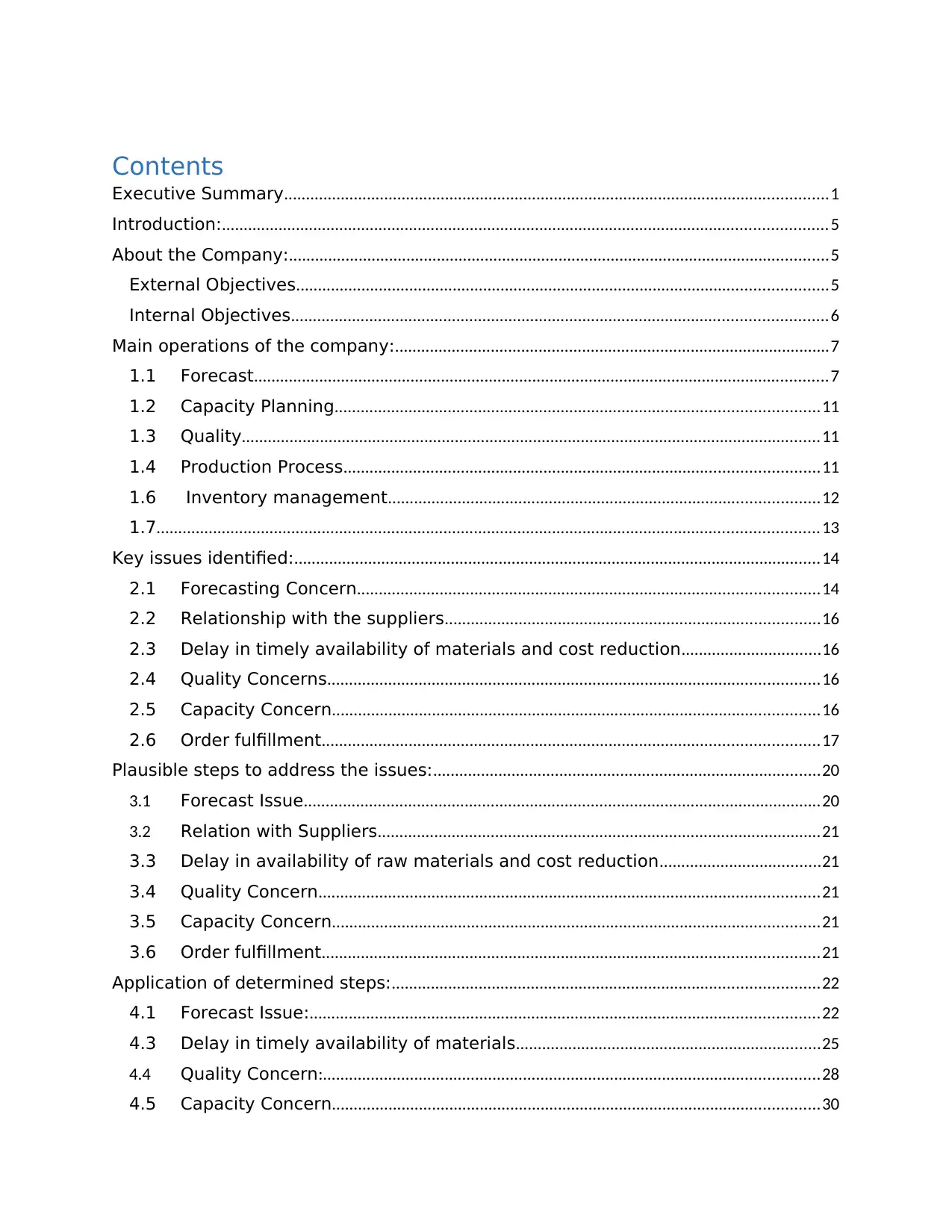
Contents
Executive Summary.............................................................................................................................1
Introduction:...........................................................................................................................................5
About the Company:............................................................................................................................5
External Objectives..........................................................................................................................5
Internal Objectives...........................................................................................................................6
Main operations of the company:....................................................................................................7
1.1 Forecast....................................................................................................................................7
1.2 Capacity Planning...............................................................................................................11
1.3 Quality.....................................................................................................................................11
1.4 Production Process.............................................................................................................11
1.6 Inventory management...................................................................................................12
1.7........................................................................................................................................................13
Key issues identified:.........................................................................................................................14
2.1 Forecasting Concern..........................................................................................................14
2.2 Relationship with the suppliers......................................................................................16
2.3 Delay in timely availability of materials and cost reduction................................16
2.4 Quality Concerns.................................................................................................................16
2.5 Capacity Concern................................................................................................................16
2.6 Order fulfillment..................................................................................................................17
Plausible steps to address the issues:.........................................................................................20
3.1 Forecast Issue.......................................................................................................................20
3.2 Relation with Suppliers......................................................................................................21
3.3 Delay in availability of raw materials and cost reduction.....................................21
3.4 Quality Concern...................................................................................................................21
3.5 Capacity Concern................................................................................................................21
3.6 Order fulfillment..................................................................................................................21
Application of determined steps:..................................................................................................22
4.1 Forecast Issue:.....................................................................................................................22
4.3 Delay in timely availability of materials......................................................................25
4.4 Quality Concern:..................................................................................................................28
4.5 Capacity Concern................................................................................................................30
Executive Summary.............................................................................................................................1
Introduction:...........................................................................................................................................5
About the Company:............................................................................................................................5
External Objectives..........................................................................................................................5
Internal Objectives...........................................................................................................................6
Main operations of the company:....................................................................................................7
1.1 Forecast....................................................................................................................................7
1.2 Capacity Planning...............................................................................................................11
1.3 Quality.....................................................................................................................................11
1.4 Production Process.............................................................................................................11
1.6 Inventory management...................................................................................................12
1.7........................................................................................................................................................13
Key issues identified:.........................................................................................................................14
2.1 Forecasting Concern..........................................................................................................14
2.2 Relationship with the suppliers......................................................................................16
2.3 Delay in timely availability of materials and cost reduction................................16
2.4 Quality Concerns.................................................................................................................16
2.5 Capacity Concern................................................................................................................16
2.6 Order fulfillment..................................................................................................................17
Plausible steps to address the issues:.........................................................................................20
3.1 Forecast Issue.......................................................................................................................20
3.2 Relation with Suppliers......................................................................................................21
3.3 Delay in availability of raw materials and cost reduction.....................................21
3.4 Quality Concern...................................................................................................................21
3.5 Capacity Concern................................................................................................................21
3.6 Order fulfillment..................................................................................................................21
Application of determined steps:..................................................................................................22
4.1 Forecast Issue:.....................................................................................................................22
4.3 Delay in timely availability of materials......................................................................25
4.4 Quality Concern:..................................................................................................................28
4.5 Capacity Concern................................................................................................................30
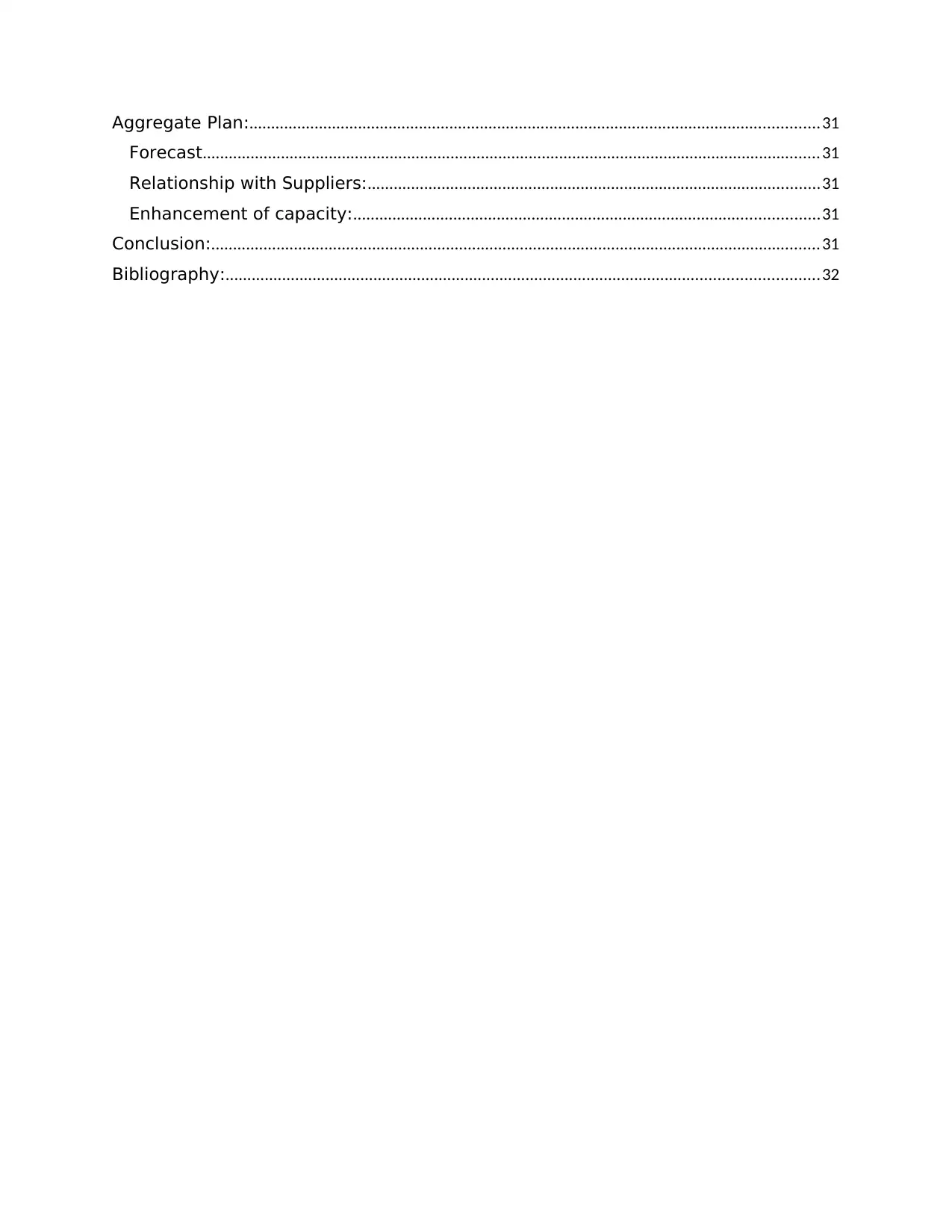
Aggregate Plan:...................................................................................................................................31
Forecast..............................................................................................................................................31
Relationship with Suppliers:........................................................................................................31
Enhancement of capacity:...........................................................................................................31
Conclusion:............................................................................................................................................31
Bibliography:........................................................................................................................................32
Forecast..............................................................................................................................................31
Relationship with Suppliers:........................................................................................................31
Enhancement of capacity:...........................................................................................................31
Conclusion:............................................................................................................................................31
Bibliography:........................................................................................................................................32
⊘ This is a preview!⊘
Do you want full access?
Subscribe today to unlock all pages.

Trusted by 1+ million students worldwide
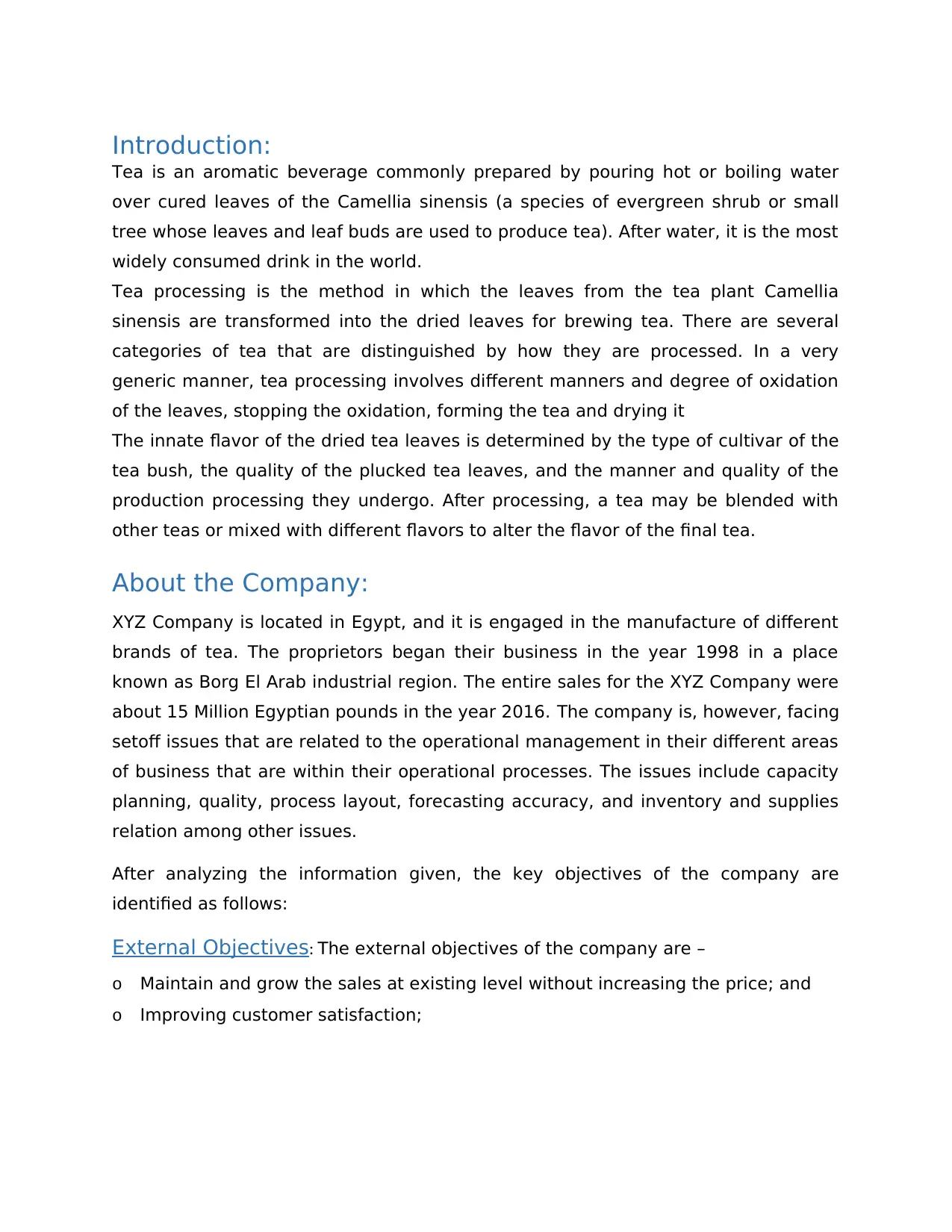
Introduction:
Tea is an aromatic beverage commonly prepared by pouring hot or boiling water
over cured leaves of the Camellia sinensis (a species of evergreen shrub or small
tree whose leaves and leaf buds are used to produce tea). After water, it is the most
widely consumed drink in the world.
Tea processing is the method in which the leaves from the tea plant Camellia
sinensis are transformed into the dried leaves for brewing tea. There are several
categories of tea that are distinguished by how they are processed. In a very
generic manner, tea processing involves different manners and degree of oxidation
of the leaves, stopping the oxidation, forming the tea and drying it
The innate flavor of the dried tea leaves is determined by the type of cultivar of the
tea bush, the quality of the plucked tea leaves, and the manner and quality of the
production processing they undergo. After processing, a tea may be blended with
other teas or mixed with different flavors to alter the flavor of the final tea.
About the Company:
XYZ Company is located in Egypt, and it is engaged in the manufacture of different
brands of tea. The proprietors began their business in the year 1998 in a place
known as Borg El Arab industrial region. The entire sales for the XYZ Company were
about 15 Million Egyptian pounds in the year 2016. The company is, however, facing
setoff issues that are related to the operational management in their different areas
of business that are within their operational processes. The issues include capacity
planning, quality, process layout, forecasting accuracy, and inventory and supplies
relation among other issues.
After analyzing the information given, the key objectives of the company are
identified as follows:
External Objectives: The external objectives of the company are –
o Maintain and grow the sales at existing level without increasing the price; and
o Improving customer satisfaction;
Tea is an aromatic beverage commonly prepared by pouring hot or boiling water
over cured leaves of the Camellia sinensis (a species of evergreen shrub or small
tree whose leaves and leaf buds are used to produce tea). After water, it is the most
widely consumed drink in the world.
Tea processing is the method in which the leaves from the tea plant Camellia
sinensis are transformed into the dried leaves for brewing tea. There are several
categories of tea that are distinguished by how they are processed. In a very
generic manner, tea processing involves different manners and degree of oxidation
of the leaves, stopping the oxidation, forming the tea and drying it
The innate flavor of the dried tea leaves is determined by the type of cultivar of the
tea bush, the quality of the plucked tea leaves, and the manner and quality of the
production processing they undergo. After processing, a tea may be blended with
other teas or mixed with different flavors to alter the flavor of the final tea.
About the Company:
XYZ Company is located in Egypt, and it is engaged in the manufacture of different
brands of tea. The proprietors began their business in the year 1998 in a place
known as Borg El Arab industrial region. The entire sales for the XYZ Company were
about 15 Million Egyptian pounds in the year 2016. The company is, however, facing
setoff issues that are related to the operational management in their different areas
of business that are within their operational processes. The issues include capacity
planning, quality, process layout, forecasting accuracy, and inventory and supplies
relation among other issues.
After analyzing the information given, the key objectives of the company are
identified as follows:
External Objectives: The external objectives of the company are –
o Maintain and grow the sales at existing level without increasing the price; and
o Improving customer satisfaction;
Paraphrase This Document
Need a fresh take? Get an instant paraphrase of this document with our AI Paraphraser
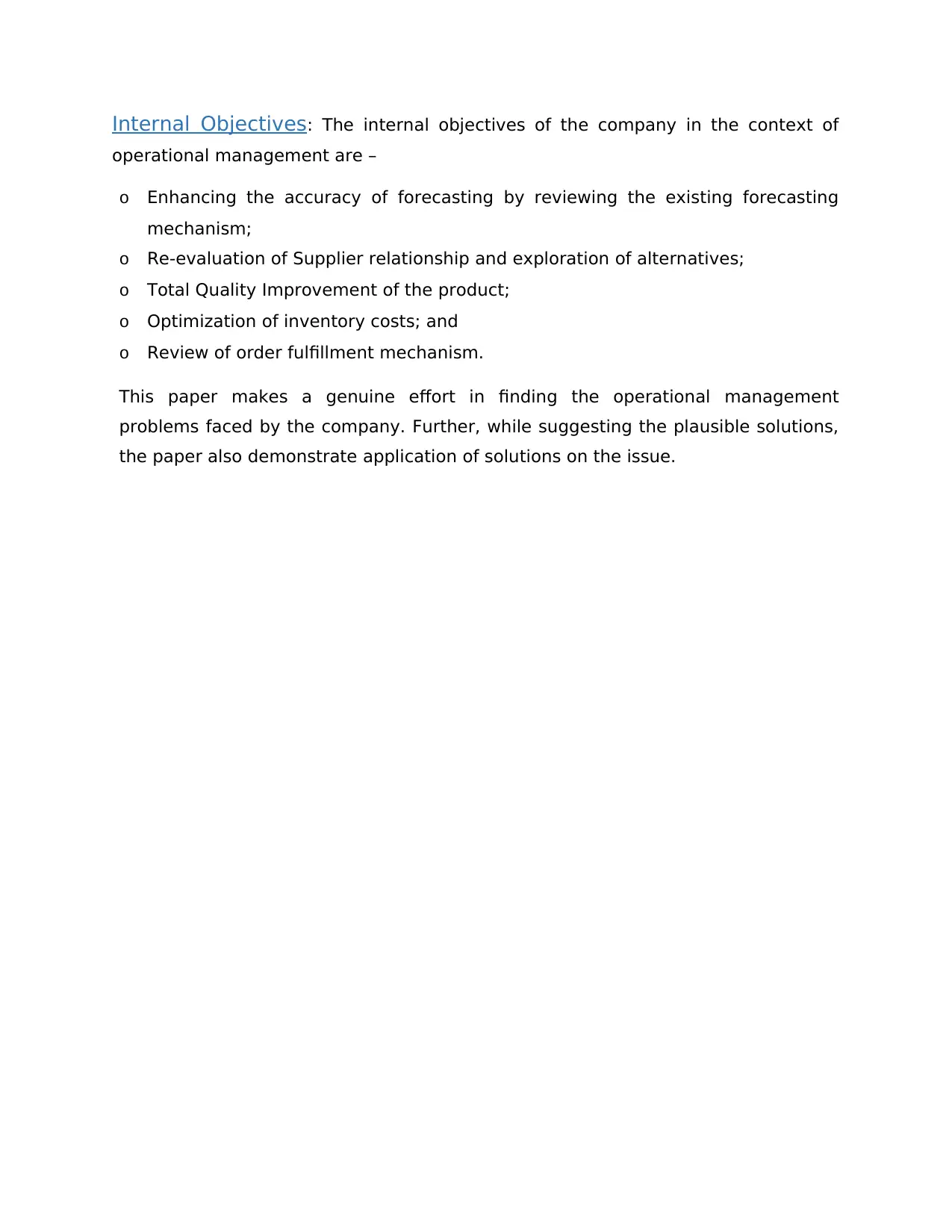
Internal Objectives: The internal objectives of the company in the context of
operational management are –
o Enhancing the accuracy of forecasting by reviewing the existing forecasting
mechanism;
o Re-evaluation of Supplier relationship and exploration of alternatives;
o Total Quality Improvement of the product;
o Optimization of inventory costs; and
o Review of order fulfillment mechanism.
This paper makes a genuine effort in finding the operational management
problems faced by the company. Further, while suggesting the plausible solutions,
the paper also demonstrate application of solutions on the issue.
operational management are –
o Enhancing the accuracy of forecasting by reviewing the existing forecasting
mechanism;
o Re-evaluation of Supplier relationship and exploration of alternatives;
o Total Quality Improvement of the product;
o Optimization of inventory costs; and
o Review of order fulfillment mechanism.
This paper makes a genuine effort in finding the operational management
problems faced by the company. Further, while suggesting the plausible solutions,
the paper also demonstrate application of solutions on the issue.
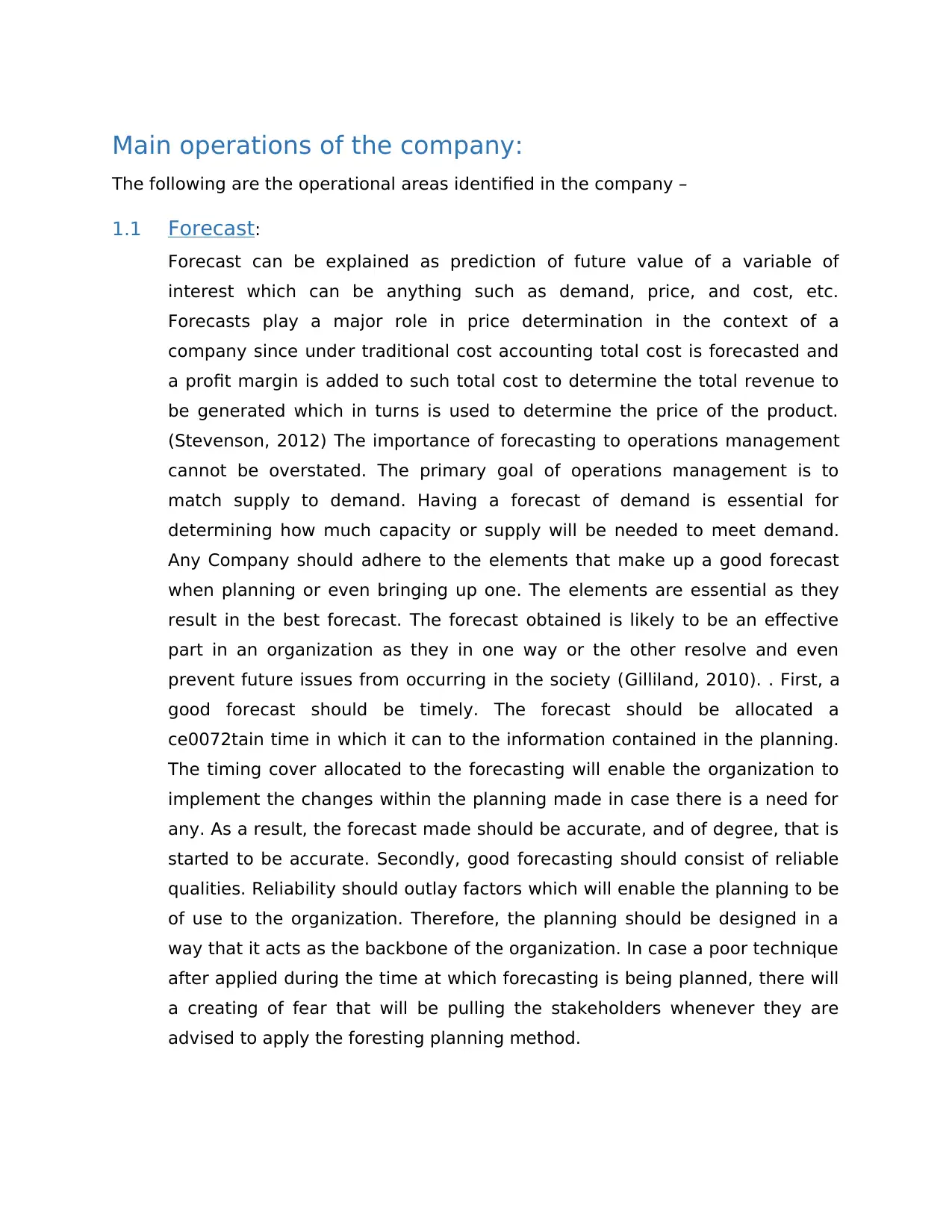
Main operations of the company:
The following are the operational areas identified in the company –
1.1 Forecast:
Forecast can be explained as prediction of future value of a variable of
interest which can be anything such as demand, price, and cost, etc.
Forecasts play a major role in price determination in the context of a
company since under traditional cost accounting total cost is forecasted and
a profit margin is added to such total cost to determine the total revenue to
be generated which in turns is used to determine the price of the product.
(Stevenson, 2012) The importance of forecasting to operations management
cannot be overstated. The primary goal of operations management is to
match supply to demand. Having a forecast of demand is essential for
determining how much capacity or supply will be needed to meet demand.
Any Company should adhere to the elements that make up a good forecast
when planning or even bringing up one. The elements are essential as they
result in the best forecast. The forecast obtained is likely to be an effective
part in an organization as they in one way or the other resolve and even
prevent future issues from occurring in the society (Gilliland, 2010). . First, a
good forecast should be timely. The forecast should be allocated a
ce0072tain time in which it can to the information contained in the planning.
The timing cover allocated to the forecasting will enable the organization to
implement the changes within the planning made in case there is a need for
any. As a result, the forecast made should be accurate, and of degree, that is
started to be accurate. Secondly, good forecasting should consist of reliable
qualities. Reliability should outlay factors which will enable the planning to be
of use to the organization. Therefore, the planning should be designed in a
way that it acts as the backbone of the organization. In case a poor technique
after applied during the time at which forecasting is being planned, there will
a creating of fear that will be pulling the stakeholders whenever they are
advised to apply the foresting planning method.
The following are the operational areas identified in the company –
1.1 Forecast:
Forecast can be explained as prediction of future value of a variable of
interest which can be anything such as demand, price, and cost, etc.
Forecasts play a major role in price determination in the context of a
company since under traditional cost accounting total cost is forecasted and
a profit margin is added to such total cost to determine the total revenue to
be generated which in turns is used to determine the price of the product.
(Stevenson, 2012) The importance of forecasting to operations management
cannot be overstated. The primary goal of operations management is to
match supply to demand. Having a forecast of demand is essential for
determining how much capacity or supply will be needed to meet demand.
Any Company should adhere to the elements that make up a good forecast
when planning or even bringing up one. The elements are essential as they
result in the best forecast. The forecast obtained is likely to be an effective
part in an organization as they in one way or the other resolve and even
prevent future issues from occurring in the society (Gilliland, 2010). . First, a
good forecast should be timely. The forecast should be allocated a
ce0072tain time in which it can to the information contained in the planning.
The timing cover allocated to the forecasting will enable the organization to
implement the changes within the planning made in case there is a need for
any. As a result, the forecast made should be accurate, and of degree, that is
started to be accurate. Secondly, good forecasting should consist of reliable
qualities. Reliability should outlay factors which will enable the planning to be
of use to the organization. Therefore, the planning should be designed in a
way that it acts as the backbone of the organization. In case a poor technique
after applied during the time at which forecasting is being planned, there will
a creating of fear that will be pulling the stakeholders whenever they are
advised to apply the foresting planning method.
⊘ This is a preview!⊘
Do you want full access?
Subscribe today to unlock all pages.

Trusted by 1+ million students worldwide
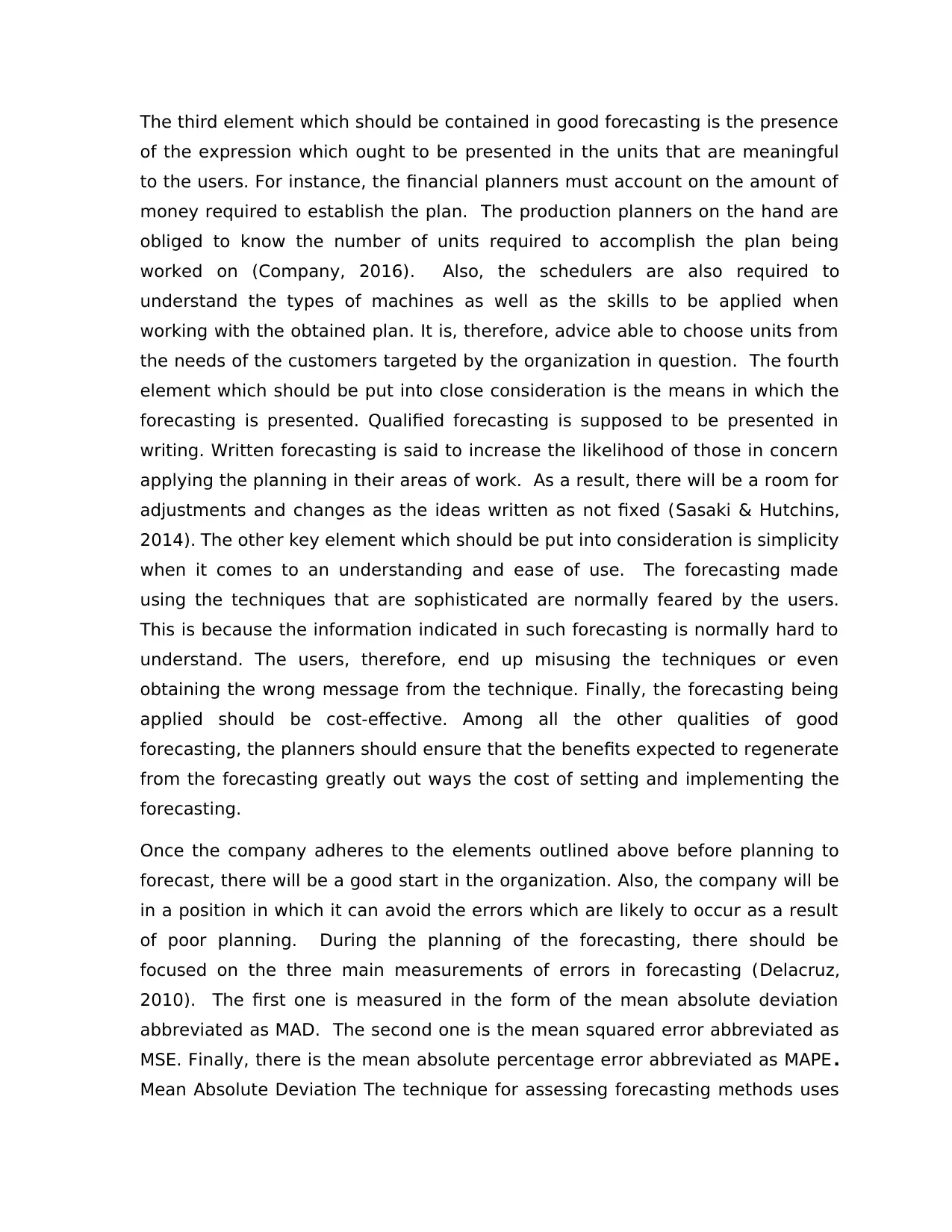
The third element which should be contained in good forecasting is the presence
of the expression which ought to be presented in the units that are meaningful
to the users. For instance, the financial planners must account on the amount of
money required to establish the plan. The production planners on the hand are
obliged to know the number of units required to accomplish the plan being
worked on (Company, 2016). Also, the schedulers are also required to
understand the types of machines as well as the skills to be applied when
working with the obtained plan. It is, therefore, advice able to choose units from
the needs of the customers targeted by the organization in question. The fourth
element which should be put into close consideration is the means in which the
forecasting is presented. Qualified forecasting is supposed to be presented in
writing. Written forecasting is said to increase the likelihood of those in concern
applying the planning in their areas of work. As a result, there will be a room for
adjustments and changes as the ideas written as not fixed (Sasaki & Hutchins,
2014). The other key element which should be put into consideration is simplicity
when it comes to an understanding and ease of use. The forecasting made
using the techniques that are sophisticated are normally feared by the users.
This is because the information indicated in such forecasting is normally hard to
understand. The users, therefore, end up misusing the techniques or even
obtaining the wrong message from the technique. Finally, the forecasting being
applied should be cost-effective. Among all the other qualities of good
forecasting, the planners should ensure that the benefits expected to regenerate
from the forecasting greatly out ways the cost of setting and implementing the
forecasting.
Once the company adheres to the elements outlined above before planning to
forecast, there will be a good start in the organization. Also, the company will be
in a position in which it can avoid the errors which are likely to occur as a result
of poor planning. During the planning of the forecasting, there should be
focused on the three main measurements of errors in forecasting (Delacruz,
2010). The first one is measured in the form of the mean absolute deviation
abbreviated as MAD. The second one is the mean squared error abbreviated as
MSE. Finally, there is the mean absolute percentage error abbreviated as MAPE .
Mean Absolute Deviation The technique for assessing forecasting methods uses
of the expression which ought to be presented in the units that are meaningful
to the users. For instance, the financial planners must account on the amount of
money required to establish the plan. The production planners on the hand are
obliged to know the number of units required to accomplish the plan being
worked on (Company, 2016). Also, the schedulers are also required to
understand the types of machines as well as the skills to be applied when
working with the obtained plan. It is, therefore, advice able to choose units from
the needs of the customers targeted by the organization in question. The fourth
element which should be put into close consideration is the means in which the
forecasting is presented. Qualified forecasting is supposed to be presented in
writing. Written forecasting is said to increase the likelihood of those in concern
applying the planning in their areas of work. As a result, there will be a room for
adjustments and changes as the ideas written as not fixed (Sasaki & Hutchins,
2014). The other key element which should be put into consideration is simplicity
when it comes to an understanding and ease of use. The forecasting made
using the techniques that are sophisticated are normally feared by the users.
This is because the information indicated in such forecasting is normally hard to
understand. The users, therefore, end up misusing the techniques or even
obtaining the wrong message from the technique. Finally, the forecasting being
applied should be cost-effective. Among all the other qualities of good
forecasting, the planners should ensure that the benefits expected to regenerate
from the forecasting greatly out ways the cost of setting and implementing the
forecasting.
Once the company adheres to the elements outlined above before planning to
forecast, there will be a good start in the organization. Also, the company will be
in a position in which it can avoid the errors which are likely to occur as a result
of poor planning. During the planning of the forecasting, there should be
focused on the three main measurements of errors in forecasting (Delacruz,
2010). The first one is measured in the form of the mean absolute deviation
abbreviated as MAD. The second one is the mean squared error abbreviated as
MSE. Finally, there is the mean absolute percentage error abbreviated as MAPE .
Mean Absolute Deviation The technique for assessing forecasting methods uses
Paraphrase This Document
Need a fresh take? Get an instant paraphrase of this document with our AI Paraphraser
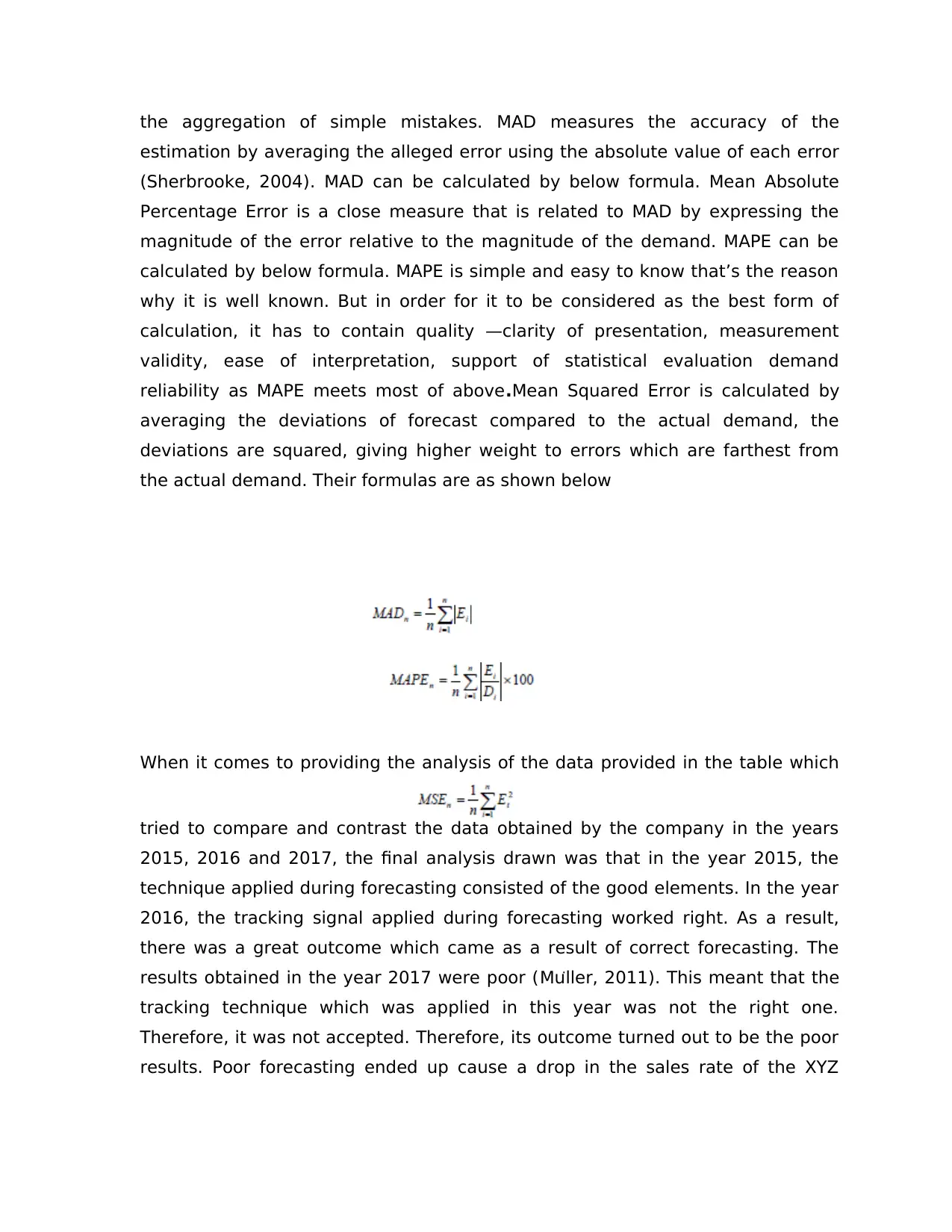
the aggregation of simple mistakes. MAD measures the accuracy of the
estimation by averaging the alleged error using the absolute value of each error
(Sherbrooke, 2004). MAD can be calculated by below formula. Mean Absolute
Percentage Error is a close measure that is related to MAD by expressing the
magnitude of the error relative to the magnitude of the demand. MAPE can be
calculated by below formula. MAPE is simple and easy to know that’s the reason
why it is well known. But in order for it to be considered as the best form of
calculation, it has to contain quality —clarity of presentation, measurement
validity, ease of interpretation, support of statistical evaluation demand
reliability as MAPE meets most of above.Mean Squared Error is calculated by
averaging the deviations of forecast compared to the actual demand, the
deviations are squared, giving higher weight to errors which are farthest from
the actual demand. Their formulas are as shown below
When it comes to providing the analysis of the data provided in the table which
tried to compare and contrast the data obtained by the company in the years
2015, 2016 and 2017, the final analysis drawn was that in the year 2015, the
technique applied during forecasting consisted of the good elements. In the year
2016, the tracking signal applied during forecasting worked right. As a result,
there was a great outcome which came as a result of correct forecasting. The
results obtained in the year 2017 were poor (Mü ller, 2011). This meant that the
tracking technique which was applied in this year was not the right one.
Therefore, it was not accepted. Therefore, its outcome turned out to be the poor
results. Poor forecasting ended up cause a drop in the sales rate of the XYZ
estimation by averaging the alleged error using the absolute value of each error
(Sherbrooke, 2004). MAD can be calculated by below formula. Mean Absolute
Percentage Error is a close measure that is related to MAD by expressing the
magnitude of the error relative to the magnitude of the demand. MAPE can be
calculated by below formula. MAPE is simple and easy to know that’s the reason
why it is well known. But in order for it to be considered as the best form of
calculation, it has to contain quality —clarity of presentation, measurement
validity, ease of interpretation, support of statistical evaluation demand
reliability as MAPE meets most of above.Mean Squared Error is calculated by
averaging the deviations of forecast compared to the actual demand, the
deviations are squared, giving higher weight to errors which are farthest from
the actual demand. Their formulas are as shown below
When it comes to providing the analysis of the data provided in the table which
tried to compare and contrast the data obtained by the company in the years
2015, 2016 and 2017, the final analysis drawn was that in the year 2015, the
technique applied during forecasting consisted of the good elements. In the year
2016, the tracking signal applied during forecasting worked right. As a result,
there was a great outcome which came as a result of correct forecasting. The
results obtained in the year 2017 were poor (Mü ller, 2011). This meant that the
tracking technique which was applied in this year was not the right one.
Therefore, it was not accepted. Therefore, its outcome turned out to be the poor
results. Poor forecasting ended up cause a drop in the sales rate of the XYZ
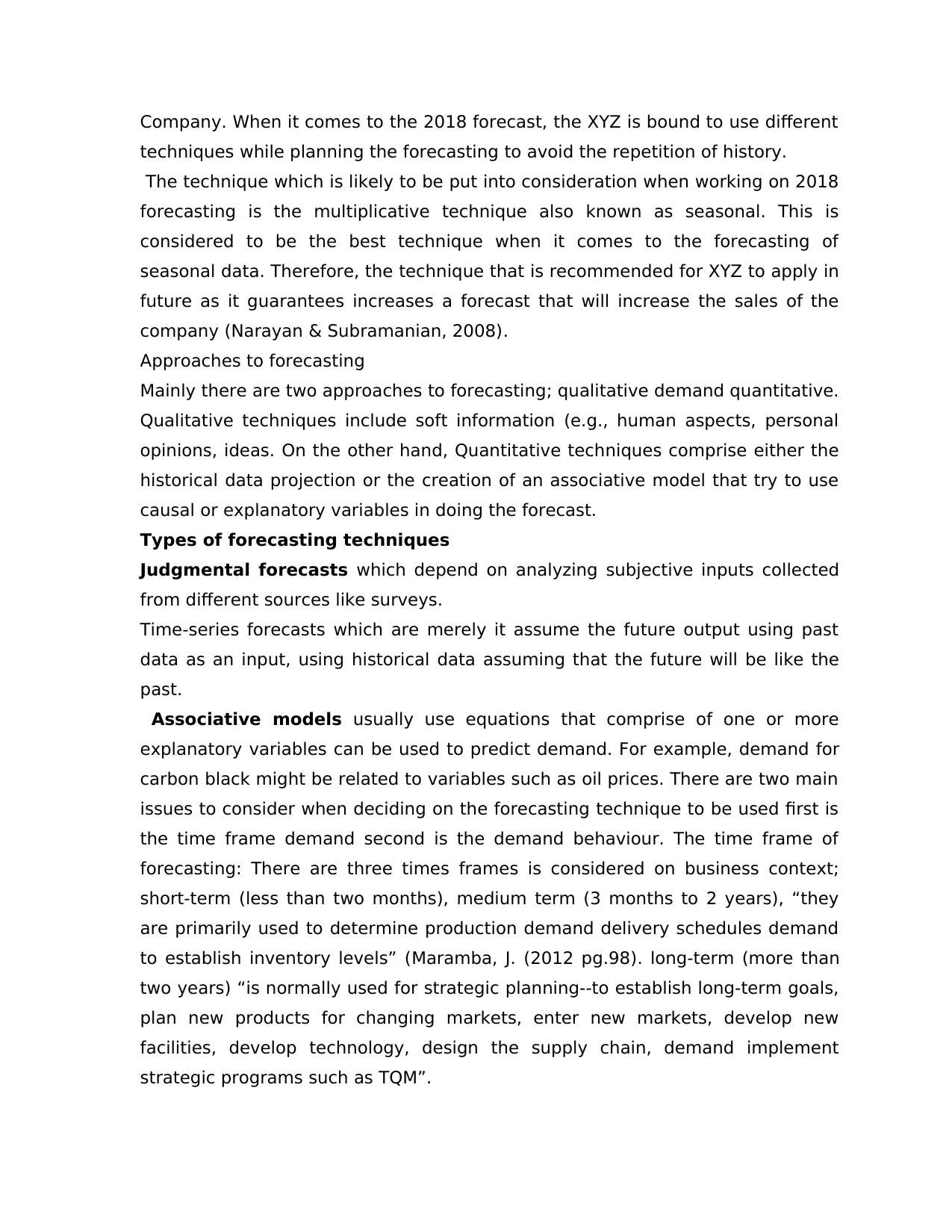
Company. When it comes to the 2018 forecast, the XYZ is bound to use different
techniques while planning the forecasting to avoid the repetition of history.
The technique which is likely to be put into consideration when working on 2018
forecasting is the multiplicative technique also known as seasonal. This is
considered to be the best technique when it comes to the forecasting of
seasonal data. Therefore, the technique that is recommended for XYZ to apply in
future as it guarantees increases a forecast that will increase the sales of the
company (Narayan & Subramanian, 2008).
Approaches to forecasting
Mainly there are two approaches to forecasting; qualitative demand quantitative.
Qualitative techniques include soft information (e.g., human aspects, personal
opinions, ideas. On the other hand, Quantitative techniques comprise either the
historical data projection or the creation of an associative model that try to use
causal or explanatory variables in doing the forecast.
Types of forecasting techniques
Judgmental forecasts which depend on analyzing subjective inputs collected
from different sources like surveys.
Time-series forecasts which are merely it assume the future output using past
data as an input, using historical data assuming that the future will be like the
past.
Associative models usually use equations that comprise of one or more
explanatory variables can be used to predict demand. For example, demand for
carbon black might be related to variables such as oil prices. There are two main
issues to consider when deciding on the forecasting technique to be used first is
the time frame demand second is the demand behaviour. The time frame of
forecasting: There are three times frames is considered on business context;
short-term (less than two months), medium term (3 months to 2 years), “they
are primarily used to determine production demand delivery schedules demand
to establish inventory levels” (Maramba, J. (2012 pg.98). long-term (more than
two years) “is normally used for strategic planning--to establish long-term goals,
plan new products for changing markets, enter new markets, develop new
facilities, develop technology, design the supply chain, demand implement
strategic programs such as TQM”.
techniques while planning the forecasting to avoid the repetition of history.
The technique which is likely to be put into consideration when working on 2018
forecasting is the multiplicative technique also known as seasonal. This is
considered to be the best technique when it comes to the forecasting of
seasonal data. Therefore, the technique that is recommended for XYZ to apply in
future as it guarantees increases a forecast that will increase the sales of the
company (Narayan & Subramanian, 2008).
Approaches to forecasting
Mainly there are two approaches to forecasting; qualitative demand quantitative.
Qualitative techniques include soft information (e.g., human aspects, personal
opinions, ideas. On the other hand, Quantitative techniques comprise either the
historical data projection or the creation of an associative model that try to use
causal or explanatory variables in doing the forecast.
Types of forecasting techniques
Judgmental forecasts which depend on analyzing subjective inputs collected
from different sources like surveys.
Time-series forecasts which are merely it assume the future output using past
data as an input, using historical data assuming that the future will be like the
past.
Associative models usually use equations that comprise of one or more
explanatory variables can be used to predict demand. For example, demand for
carbon black might be related to variables such as oil prices. There are two main
issues to consider when deciding on the forecasting technique to be used first is
the time frame demand second is the demand behaviour. The time frame of
forecasting: There are three times frames is considered on business context;
short-term (less than two months), medium term (3 months to 2 years), “they
are primarily used to determine production demand delivery schedules demand
to establish inventory levels” (Maramba, J. (2012 pg.98). long-term (more than
two years) “is normally used for strategic planning--to establish long-term goals,
plan new products for changing markets, enter new markets, develop new
facilities, develop technology, design the supply chain, demand implement
strategic programs such as TQM”.
⊘ This is a preview!⊘
Do you want full access?
Subscribe today to unlock all pages.

Trusted by 1+ million students worldwide
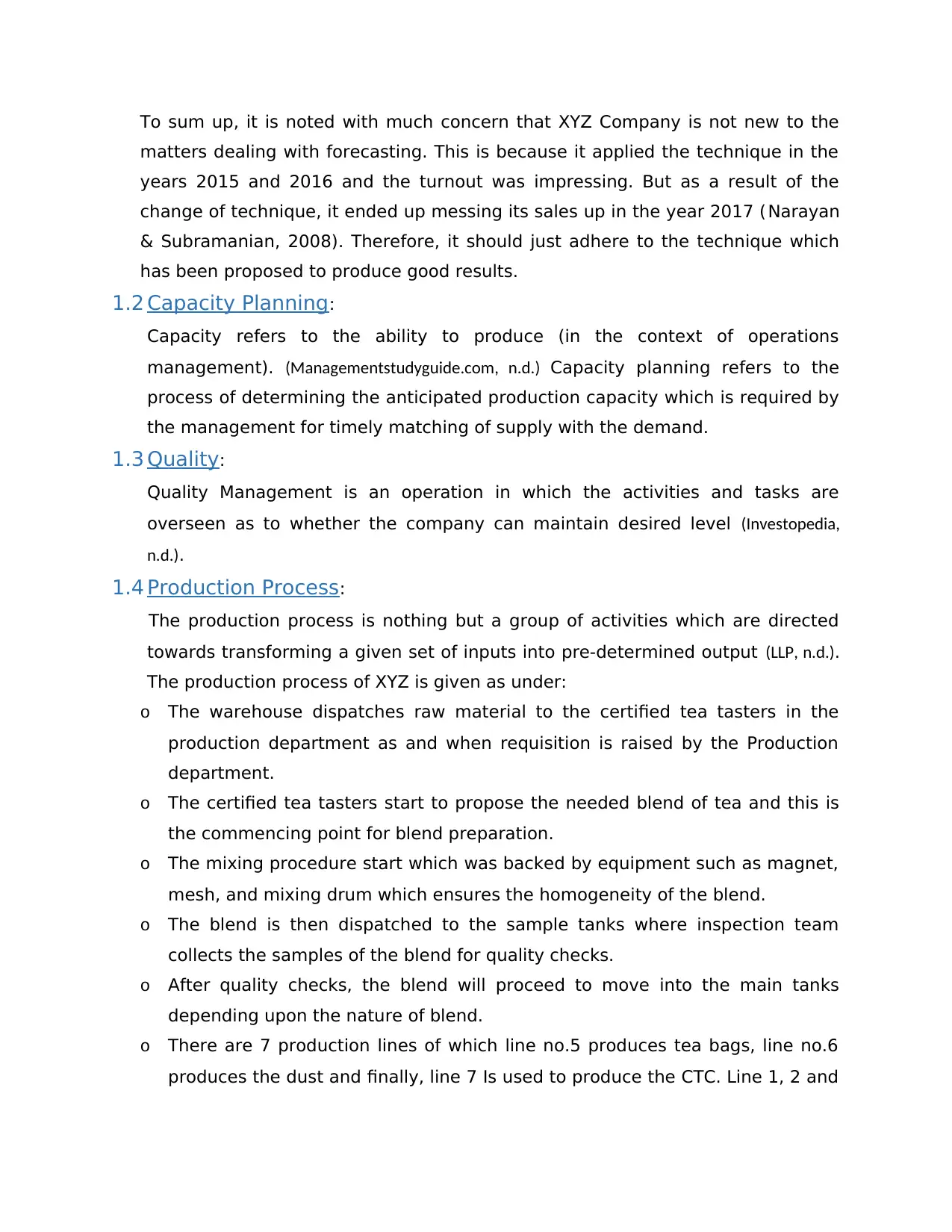
To sum up, it is noted with much concern that XYZ Company is not new to the
matters dealing with forecasting. This is because it applied the technique in the
years 2015 and 2016 and the turnout was impressing. But as a result of the
change of technique, it ended up messing its sales up in the year 2017 ( Narayan
& Subramanian, 2008). Therefore, it should just adhere to the technique which
has been proposed to produce good results.
1.2 Capacity Planning:
Capacity refers to the ability to produce (in the context of operations
management). (Managementstudyguide.com, n.d.) Capacity planning refers to the
process of determining the anticipated production capacity which is required by
the management for timely matching of supply with the demand.
1.3 Quality:
Quality Management is an operation in which the activities and tasks are
overseen as to whether the company can maintain desired level (Investopedia,
n.d.).
1.4 Production Process:
The production process is nothing but a group of activities which are directed
towards transforming a given set of inputs into pre-determined output (LLP, n.d.).
The production process of XYZ is given as under:
o The warehouse dispatches raw material to the certified tea tasters in the
production department as and when requisition is raised by the Production
department.
o The certified tea tasters start to propose the needed blend of tea and this is
the commencing point for blend preparation.
o The mixing procedure start which was backed by equipment such as magnet,
mesh, and mixing drum which ensures the homogeneity of the blend.
o The blend is then dispatched to the sample tanks where inspection team
collects the samples of the blend for quality checks.
o After quality checks, the blend will proceed to move into the main tanks
depending upon the nature of blend.
o There are 7 production lines of which line no.5 produces tea bags, line no.6
produces the dust and finally, line 7 Is used to produce the CTC. Line 1, 2 and
matters dealing with forecasting. This is because it applied the technique in the
years 2015 and 2016 and the turnout was impressing. But as a result of the
change of technique, it ended up messing its sales up in the year 2017 ( Narayan
& Subramanian, 2008). Therefore, it should just adhere to the technique which
has been proposed to produce good results.
1.2 Capacity Planning:
Capacity refers to the ability to produce (in the context of operations
management). (Managementstudyguide.com, n.d.) Capacity planning refers to the
process of determining the anticipated production capacity which is required by
the management for timely matching of supply with the demand.
1.3 Quality:
Quality Management is an operation in which the activities and tasks are
overseen as to whether the company can maintain desired level (Investopedia,
n.d.).
1.4 Production Process:
The production process is nothing but a group of activities which are directed
towards transforming a given set of inputs into pre-determined output (LLP, n.d.).
The production process of XYZ is given as under:
o The warehouse dispatches raw material to the certified tea tasters in the
production department as and when requisition is raised by the Production
department.
o The certified tea tasters start to propose the needed blend of tea and this is
the commencing point for blend preparation.
o The mixing procedure start which was backed by equipment such as magnet,
mesh, and mixing drum which ensures the homogeneity of the blend.
o The blend is then dispatched to the sample tanks where inspection team
collects the samples of the blend for quality checks.
o After quality checks, the blend will proceed to move into the main tanks
depending upon the nature of blend.
o There are 7 production lines of which line no.5 produces tea bags, line no.6
produces the dust and finally, line 7 Is used to produce the CTC. Line 1, 2 and
Paraphrase This Document
Need a fresh take? Get an instant paraphrase of this document with our AI Paraphraser
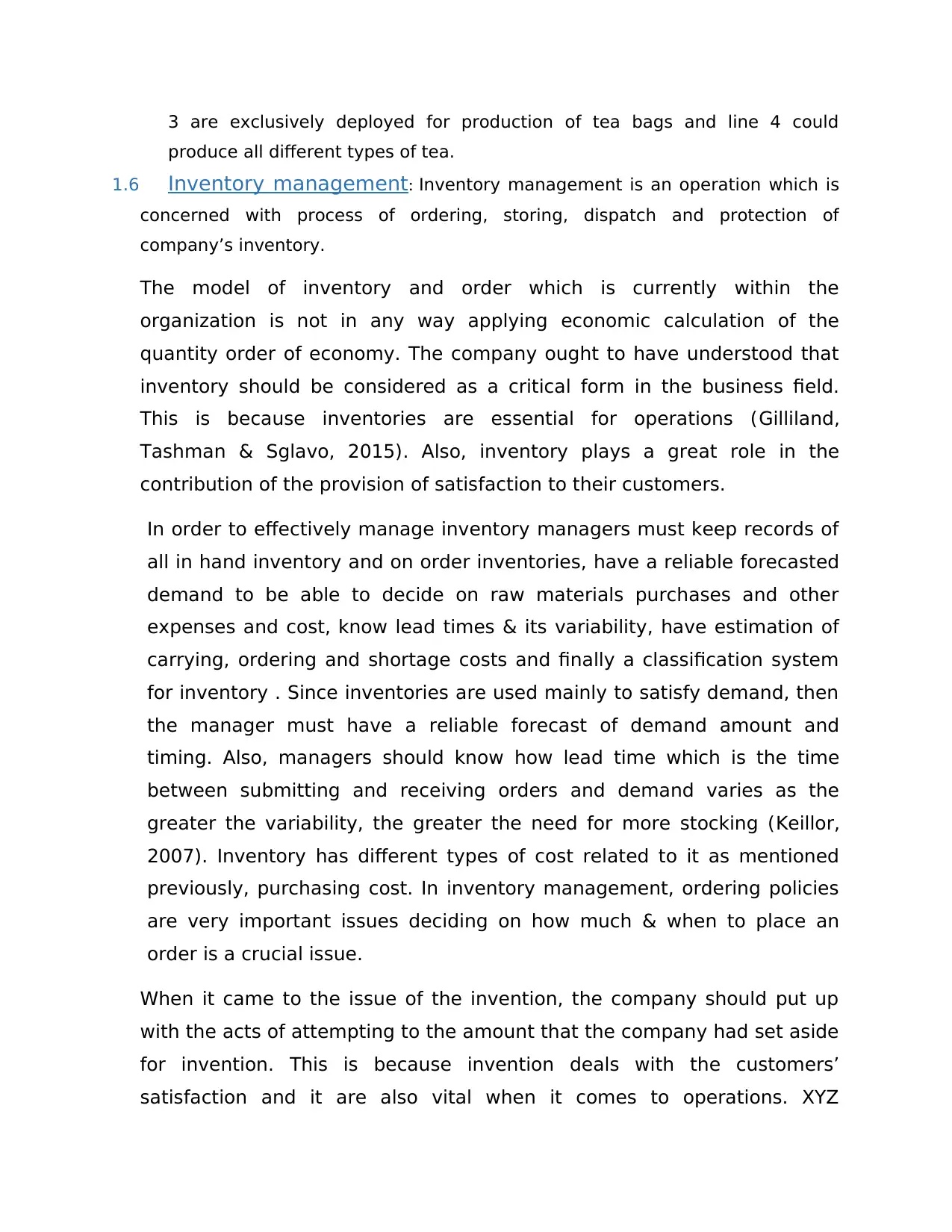
3 are exclusively deployed for production of tea bags and line 4 could
produce all different types of tea.
1.6 Inventory management: Inventory management is an operation which is
concerned with process of ordering, storing, dispatch and protection of
company’s inventory.
The model of inventory and order which is currently within the
organization is not in any way applying economic calculation of the
quantity order of economy. The company ought to have understood that
inventory should be considered as a critical form in the business field.
This is because inventories are essential for operations (Gilliland,
Tashman & Sglavo, 2015). Also, inventory plays a great role in the
contribution of the provision of satisfaction to their customers.
In order to effectively manage inventory managers must keep records of
all in hand inventory and on order inventories, have a reliable forecasted
demand to be able to decide on raw materials purchases and other
expenses and cost, know lead times & its variability, have estimation of
carrying, ordering and shortage costs and finally a classification system
for inventory . Since inventories are used mainly to satisfy demand, then
the manager must have a reliable forecast of demand amount and
timing. Also, managers should know how lead time which is the time
between submitting and receiving orders and demand varies as the
greater the variability, the greater the need for more stocking (Keillor,
2007). Inventory has different types of cost related to it as mentioned
previously, purchasing cost. In inventory management, ordering policies
are very important issues deciding on how much & when to place an
order is a crucial issue.
When it came to the issue of the invention, the company should put up
with the acts of attempting to the amount that the company had set aside
for invention. This is because invention deals with the customers’
satisfaction and it are also vital when it comes to operations. XYZ
produce all different types of tea.
1.6 Inventory management: Inventory management is an operation which is
concerned with process of ordering, storing, dispatch and protection of
company’s inventory.
The model of inventory and order which is currently within the
organization is not in any way applying economic calculation of the
quantity order of economy. The company ought to have understood that
inventory should be considered as a critical form in the business field.
This is because inventories are essential for operations (Gilliland,
Tashman & Sglavo, 2015). Also, inventory plays a great role in the
contribution of the provision of satisfaction to their customers.
In order to effectively manage inventory managers must keep records of
all in hand inventory and on order inventories, have a reliable forecasted
demand to be able to decide on raw materials purchases and other
expenses and cost, know lead times & its variability, have estimation of
carrying, ordering and shortage costs and finally a classification system
for inventory . Since inventories are used mainly to satisfy demand, then
the manager must have a reliable forecast of demand amount and
timing. Also, managers should know how lead time which is the time
between submitting and receiving orders and demand varies as the
greater the variability, the greater the need for more stocking (Keillor,
2007). Inventory has different types of cost related to it as mentioned
previously, purchasing cost. In inventory management, ordering policies
are very important issues deciding on how much & when to place an
order is a crucial issue.
When it came to the issue of the invention, the company should put up
with the acts of attempting to the amount that the company had set aside
for invention. This is because invention deals with the customers’
satisfaction and it are also vital when it comes to operations. XYZ

Company should get to understand that inventory should be considered to
be the aim which is of most important especially when it comes to
customer’s satisfactory levels (Bateman, 2012).
1.7 Order fulfillment:
` The existing mechanism of order fulfillment is as follows –
o The costumer sends order through mail or fax.
o The Marketing manager will process the orders and accidentally
cancels 1 out of 400 orders.
o All the orders processed by the marketing manager are placed into the
internal mail box and it takes 1 hour on an average to get delivered to
the pickup area.
o After delivery into the pickup area, there is a queue time of half an
hour.
o The clerk picks up and order from the pickup area and verifies whether
the requested goods are available in the stock.
o If the goods are available in the stock, the same is forwarded to an
officer in inspection department and the officer will check for the
correctness of the order. However, it is found out that one out of every
500 orders on an average is being send to transport with wrong
address.
o Once the inspection is over, the goods are sent to the transportation
department where the transportation department delivers the goods to
the customer within 2 – 3 days from the date of dispatch. While the
transport department is delivering the goods with cent percent
accuracy, it is observed that some of the deliveries are getting delayed
upto 7 days from the date of dispatch.
be the aim which is of most important especially when it comes to
customer’s satisfactory levels (Bateman, 2012).
1.7 Order fulfillment:
` The existing mechanism of order fulfillment is as follows –
o The costumer sends order through mail or fax.
o The Marketing manager will process the orders and accidentally
cancels 1 out of 400 orders.
o All the orders processed by the marketing manager are placed into the
internal mail box and it takes 1 hour on an average to get delivered to
the pickup area.
o After delivery into the pickup area, there is a queue time of half an
hour.
o The clerk picks up and order from the pickup area and verifies whether
the requested goods are available in the stock.
o If the goods are available in the stock, the same is forwarded to an
officer in inspection department and the officer will check for the
correctness of the order. However, it is found out that one out of every
500 orders on an average is being send to transport with wrong
address.
o Once the inspection is over, the goods are sent to the transportation
department where the transportation department delivers the goods to
the customer within 2 – 3 days from the date of dispatch. While the
transport department is delivering the goods with cent percent
accuracy, it is observed that some of the deliveries are getting delayed
upto 7 days from the date of dispatch.
⊘ This is a preview!⊘
Do you want full access?
Subscribe today to unlock all pages.

Trusted by 1+ million students worldwide
1 out of 32
Your All-in-One AI-Powered Toolkit for Academic Success.
+13062052269
info@desklib.com
Available 24*7 on WhatsApp / Email
![[object Object]](/_next/static/media/star-bottom.7253800d.svg)
Unlock your academic potential
Copyright © 2020–2025 A2Z Services. All Rights Reserved. Developed and managed by ZUCOL.
